A horse that pins his ears and threatens to kick out at other horses needs to be reprimanded immediately.
Attitude Adjustment for the Cranky Horse
Horses that misbehave in group situations are a hazard to themselves and others. More than likely, you’ve been on a trail ride with a pinny-eared horse that snakes his head around to bite others or tries to lash out with his hind legs. One pinny-eared horse can disrupt an otherwise enjoyable ride and create a very dangerous situation.
While no one wants to be on a pinny-eared horse, keep in mind that it’s common for horses to get a little defensive when another horse comes near them. This is especially true if the horse is a dominant horse in the herd. As the other horses are coming up on him, your horse is just saying, “Hey, you better stay back, or else!” So if your horse pins his ears or gets cranky as another horse comes up close to him, he’s not a particularly bad horse; he’s just being a horse. Now, that doesn’t mean that I accept this behavior, and neither should you, but before you start to fix a problem, it’s always good to know how and why it developed.
So why would a horse pin his ears or kick at others? It may be due to a lack of respect. Maybe you never taught your horse to respect you, or you’re not giving him enough to think about when you’re riding. As a result, he has time to cause trouble and worry about keeping other horses out of his personal space. When it comes to training horses and working with them on a daily basis, I figure the horse has 23 hours a day to do whatever he wants—eat, sleep, play, whatever. I only ask for an hour or two out of his day, and the least he can do is put on a good attitude and respect me while I’m with him. I make no excuses for cranky attitudes in my horses, whether the horse in question is a mare in heat or an extremely dominant horse in the herd. When I’m riding my horses, their attention and focus had better be on me.
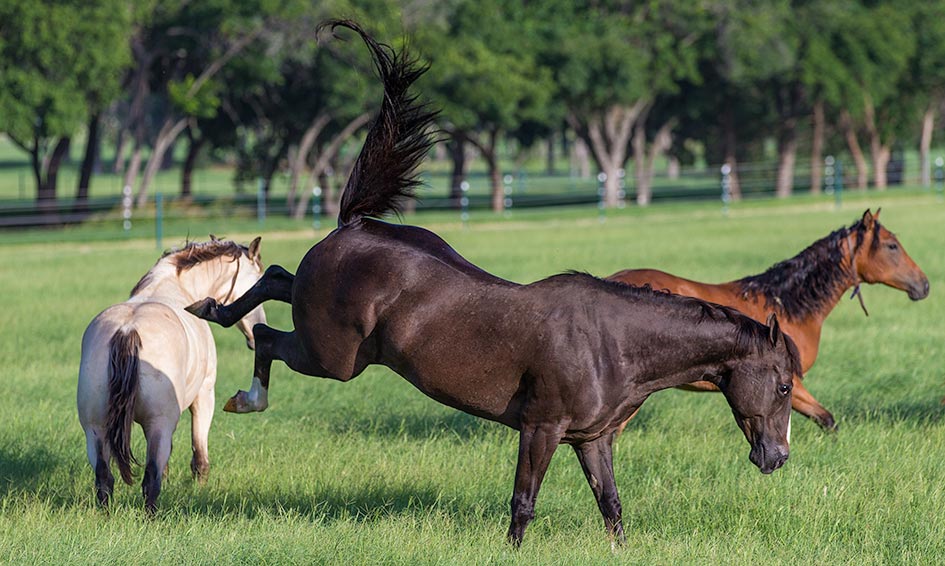
When I’m not working with my horses, I don’t care how they interact with other horses and who is the boss and who isn’t. But when I’m working with them, I’m the leader and expect my horses to be tuned in to me; not the other horses around them. I will not tolerate dangerous behavior.
Don’t Protect Your Horse
When it comes to cranky horses, there are two schools of thought on how to deal with the problem. The first approach is to avoid riding in group situations and only ride your horse when you’re sure you’ll be all alone. The second approach is to make excuses for your horse and try to take the responsibility off your shoulders and put it on someone else’s.
If your horse is kicking or pinning his ears when he’s around others, he’s telling you that you’re not keeping him busy enough and he doesn’t respect your leadership. In other words, there are holes in your foundation. A lot of groundwork—moving the horse’s feet forwards, backwards, left and right and always rewarding the slightest try—will teach him to respect you and keep his attention focused on you. Although this probably won’t cure the problem, it will certainly help by laying a foundation of respect.
The best way to get a horse over pinning his ears or kicking other horses is to expose him to other horses, let him commit to the mistake, and then correct him. Protecting him by keeping him away from other horses is not going to make his cranky attitude go away.
In fact, it will only make it worse. A lot of people who have horses that misbehave in group situations mistakenly think that keeping their horse in the barn while others are riding and only sneaking in rides when the trail is clear will fix the problem. That’s like putting a Band-Aid on a sore—it fixes nothing. Instead, I’m going to share with you two different strategies that will shape up your horse’s attitude. Generally, I start out with the first strategy by redirecting the horse’s attention back to me by bending him in a circle and hustling his feet. This is the mildest correction and not only shows the horse that he has to keep his attention on me, but proves to him that a cranky attitude means nothing but hard work. If that doesn’t work, then I’ll have to get more aggressive with my correction and make the horse feel uncomfortable for his behavior using the second strategy. In the first strategy, you’ll get the horse to focus his attention back on you and condition him to associate kicking with hard work. Horses are basically lazy creatures—they’ll always pick the path that involves the least amount of work. So by making the horse work hard every time he kicks or pins his ears, he’ll stop doing it. First, you need to set the situation up so that you can correct your horse. It’s best to practice this at home in an arena or a pasture. You wouldn’t want to take your horse on a trail ride with 12 other horses and try to address the problem. (However, if your horse does pin his ears, try to bite another horse or kick out on the trail, you can incorporate this fix right then and there.)
Ask a friend on horseback to help you. It’s important that the other horse is quiet and doesn’t have a problem with another horse being close to him. You’ll already have your hands full fixing your horse, let alone trying to deal with two cranky horses at the same time.
When you’re set to go, have your friend ride their horse about a horse-length behind your horse. You want to dare your horse to pin his ears back and act snarly, and if he truly has a problem, this shouldn’t be hard to do. When the other horse is following him, if he pins his ears back or gets cranky, immediately bend him around in a circle and kick his side with your inside leg. Then put him to work. Really make him hustle his feet.
You don’t want this to be real easy for him to do, like: “Oh Precious, you shouldn’t have done that, now let’s bend around in a circle.” Instead, you want him to clearly understand that his behavior is unacceptable and if he even acts like he’s going to get cranky, there are going to be consequences. And those consequences are moving his feet and working hard. You’re telling him, “You don’t have time to be pinning your ears back because you’re way too busy moving your feet.” This not only keeps the horse from kicking out or biting the other horse, but it also teaches him why he should avoid kicking in the first place. If he kicks, he has to work hard. A good thing to do here would be to yield the horse’s hindquarters around with a lot of energy.
Hustle the horse’s feet in the circle until you feel that he’s got his attention back on you, and then go back to having the other horse follow yours. Dare your horse to get cranky and misbehave again. If he does, no big deal, just bend him around in a circle again. You may have to repeat the process several times before the horse finally understands that when he acts cranky, you’ll make him work hard. When he remains pleasant and relaxed, you’ll leave him alone.
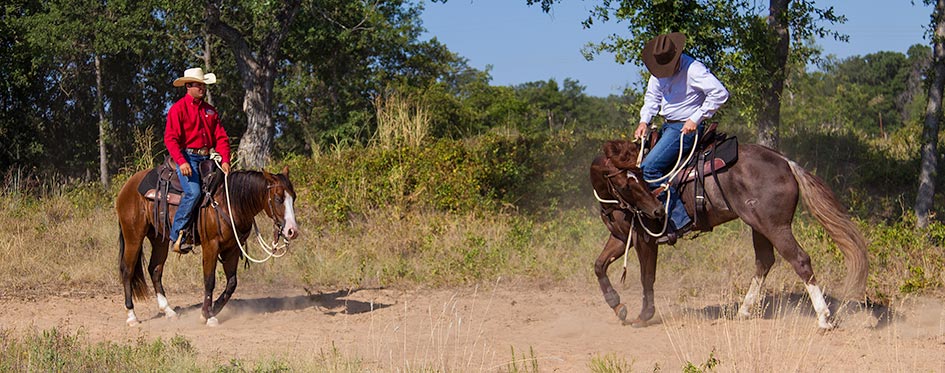
If your horse so much as pins his ears at another horse, immediately thump his ribcage with your heel and hustle his feet in circles.
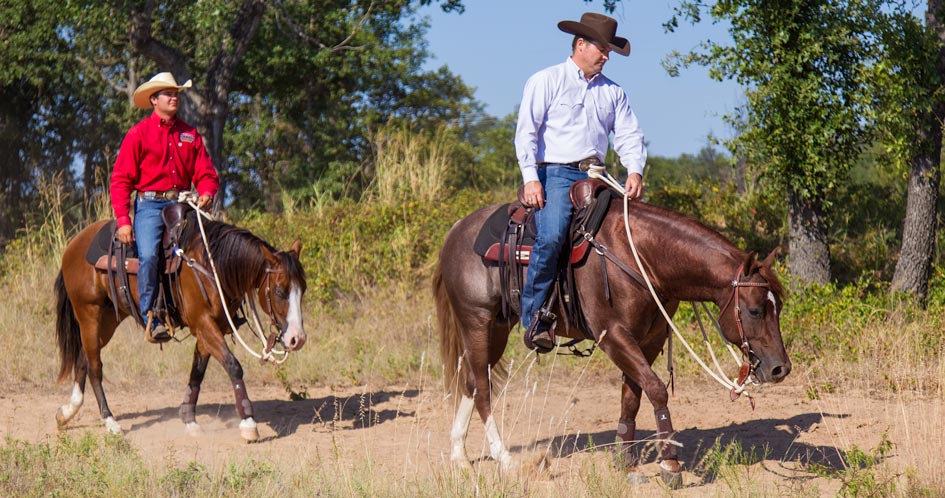
When you’ve made your correction, put the horse on a big, loose rein and walk him down the trail again. As long as he remains pleasant, you’ll leave him alone.
When Option One Fails
If you have an extremely dominant horse, you may find that this first strategy isn’t enough to make him want to change his attitude. If that’s the case, try option two. As in the first situation, you’re still going to dare the horse to act cranky by having the other horse ride close to you. However, instead of bending him around in a circle when he misbehaves, you’ll whack him between the ears with the end of your reins or a dressage whip to make him feel uncomfortable.
This may sound aggressive, but keep something in mind: When a horse is misbehaving, you need to get in and get out. Be black and white with no shades of gray.
You’re not whacking the horse hard enough that he drops to his knees and has brain damage. You’re more or less surprising him. You want him to think that every time he flattens his ears back to his neck, they hit him on the head. Your timing is really important here—you have to time the whack with the exact instant the horse pins his ears back. That way, the horse will think he’s making himself feel uncomfortable.
As the other horse is following you, keep the reins or whip in the middle of your chest or over your shoulder so that the horse can’t see it and know that the whack is coming. You want him to honestly think that he’s whacking himself with his ears, and when the whack comes, you want it to shock him. So as you’re riding along, keep the spanker over your shoulder, and as soon as the horse even acts likes he’s going to get snarly, whack him between the ears.
When you whack him, it’ll surprise him and make him throw his head up. For your part, you’ll pretend like nothing happened. Think of it like an electric fence. When you get zapped by an electric fence it doesn’t really hurt. It surprises you more than anything. It may surprise you in a way that you don’t want to be surprised again, but it doesn’t physically hurt you. It’s not like your elbow hurts 10 seconds later. Once you get zapped, it takes you by surprise and makes you say, “I’d better get away from that.” That’s kind of what you’re doing here when you spank the horse between his ears. You want him to think, “Oh man, if I pin my ears back, I’m going to actually whack myself on the top of my head with my ears.”
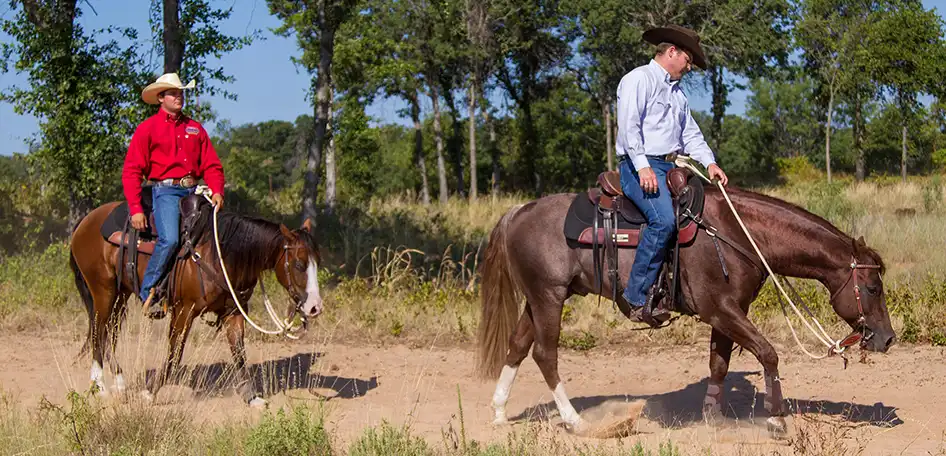
When a horse pins his ears, as mine is doing here, he’s warning all the other horses around him that they’d better getout of his way. If they don’t, he’s going to back his warning up with action, which is either to kick the other horse or bite him.
SUCCESS TIPS:
Don’t be a Nagging Mother.
The worst thing you can do to your horse is be a Nagging Mother. A Nagging Mother is a person who keeps begging their horse to do something, “Come on, Precious, stop being cranky. Please stop being cranky.” Like a fly that keeps buzzing around your face, Nagging Mothers keep annoying the horse until he either gets frustrated or reacts violently. You’re better off getting in and getting out and effectively making your correction.
When I was training horses under Gordon McKinlay, he taught me that one good whack is better than a thousand little taps. That means don’t nag the horse. Get in and get out and be black or white, because if you sit there and nag the horse, he’ll only get crankier. If he pins his ears at another horse or gets cranky, immediately correct him. Make it very obvious that his behavior is unacceptable.
Your corrections shouldn’t last more than two seconds at the very most. I want my horses to think that if they pin their ears or go to kick another horse, they’re dead. This is a very serious matter—I’ve seen people get seriously hurt by horses misbehaving around other horses. I’ve seen a lady’s kneecap get completely shattered and another lady get a broken leg from a kicking horse. When a horse kicks and gets defensive, it can be extremely dangerous, and should be treated as such.
If your horse keeps making the same mistake, he’s telling you that you’re being a Nagging Mother, meaning that you’re not giving him enough motivation to want to change his behavior. You’re stuck in a shade of gray, and not being black or white. Get in and get out and be done with it. When a horse thinks that there are no repercussions for his actions, he’ll make you correct him all the time. I want my horses to think to themselves, “I wonder what I’ve got to do to not get in trouble for pinning my ears back.” The answer is don’t pin your ears back and don’t kick at other horses. When horses are on their own time, I don’t care what they do. But when I’m around them, I’m the one who calls the shots.
A word of caution: While you don’t want to be a Nagging Mother, you also don’t want to be a Barbarian. A Barbarian is a person who loses control of his emotions and beats and whips and spurs his horse because he is frustrated and has a lack of knowledge. Just as a Nagging Mother gets inconsistent results, a Barbarian’s horse is usually too full of fear to respond correctly. You always want respect without fear.
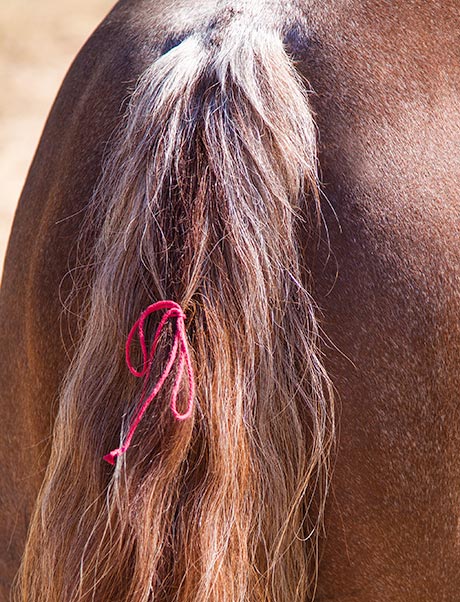
Red ribbons.
If you were ever in 4-H, Pony Club or belonged to any sort of riding group, you’ve probably heard of putting a red ribbon in the tail of a horse that kicks. The red ribbon lets all the other riders know that your horse will kick if another horse comes up near him. To me, a red ribbon in a horse’s tail is just a bogus excuse for a lazy owner who wants to take no responsibility for his horse’s training. A red ribbon says, “I know my horse kicks, but I don’t want to do anything about it. So I’m going to make an excuse and warn everybody that if you come near me, my horse is going to kick you and I’ll say, ‘I told you so!’” That doesn’t cut it with me. We each need to be responsible for our own horse’s actions.
Now, I’m certainly not going to take a horse that kicks out in the middle of a trail ride with other riders. I’m going to work on correcting his behavior at home first with one horse, and then two, etc. When your horse is misbehaving, it’s your responsibility to correct him. Tying a red ribbon in his tail and shrugging the responsibility off to others isn’t fair.
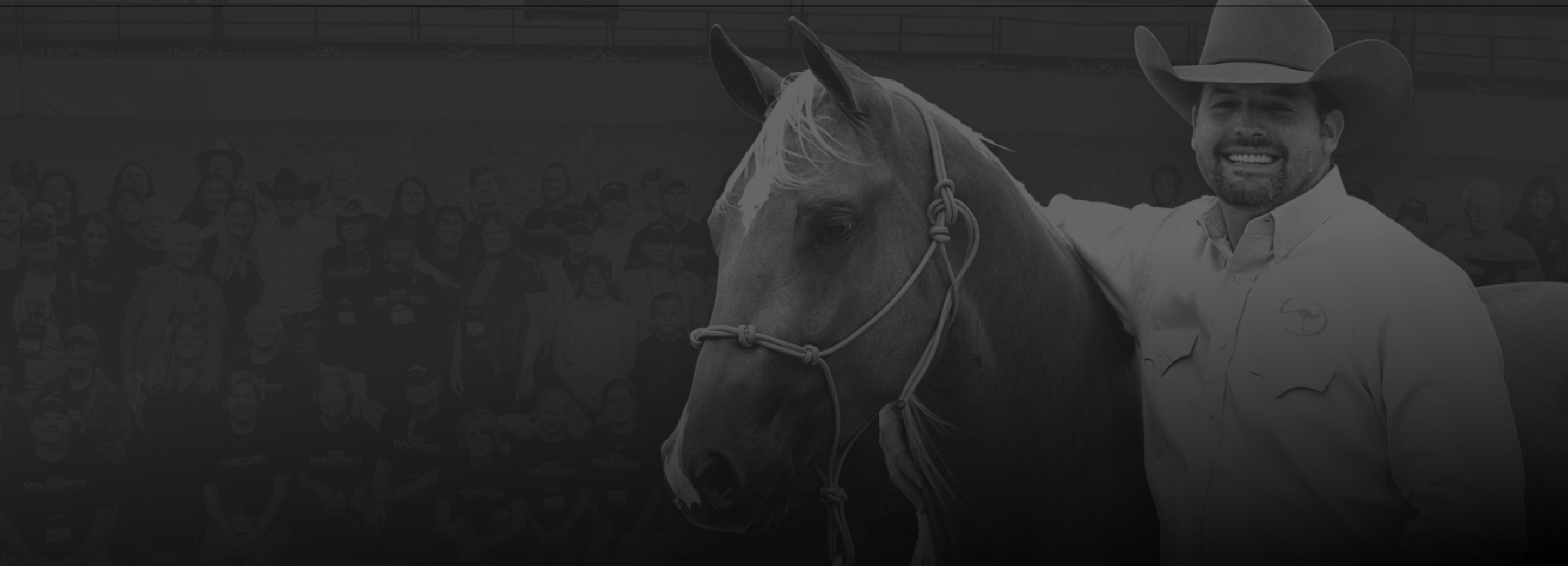
Want To Learn More? SIGN UP FOR OUR LOYALTY PROGRAM
Master your horsemanship training through Clinton’s step-by-step method videos by joining the No Worries Club today. Becoming a club member ensures you get VIP pricing on all of Clinton’s must-have training tools and resources. Plus, you’ll enjoy all the phenomenal benefits that come with club membership!



